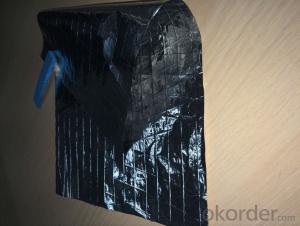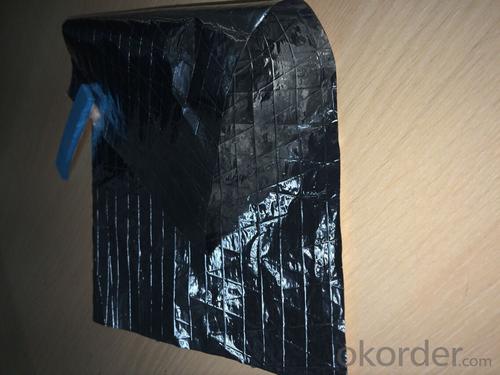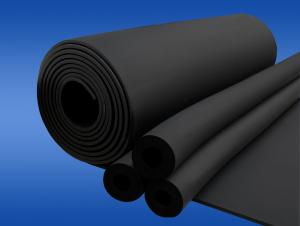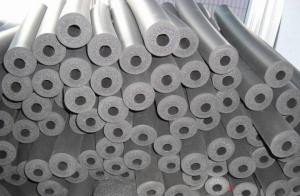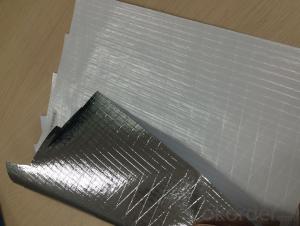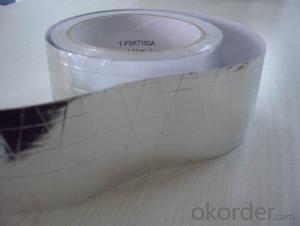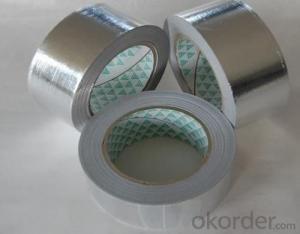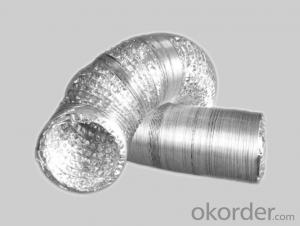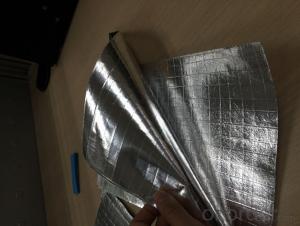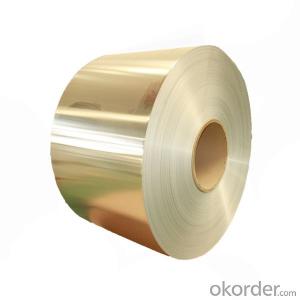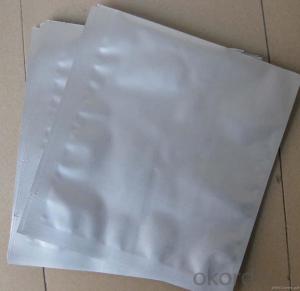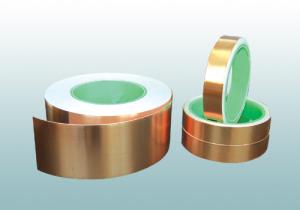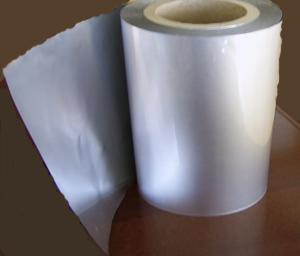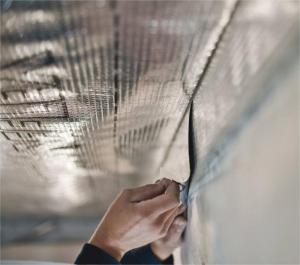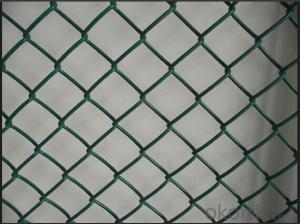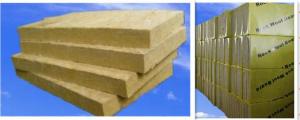CNBM Aluminum Foil Facing for Building Materials
- Loading Port:
- Shanghai
- Payment Terms:
- TT OR LC
- Min Order Qty:
- 200 m²
- Supply Capability:
- 1000000 m²/month
OKorder Service Pledge
OKorder Financial Service
You Might Also Like
1.Structure of Aluminium Foil Facing Description:
Aluminium Foil Facing Insulation provides excellent insulation: reflects up to 97% of radiant energy in addition to resisting other types of heat transfer from conduction,convection,and radiation.The side of metalized PET/Alu forms an effective barrier against moisture,air currents and vapors.It is economical solution in many field. It is a light duty, Eco grade D/S foil Insulation. It is ideally used as sarking and insulation under roofs , in walls behind cladding or under timber floors , for residential and commercial building. Combining with glasswool or foam insulation, it is excellent as a vapor barrier for air-conditioning ducts, pipes and vessels.
2.Main Features of the Aluminium Foil Facing Insulation:
High heat reflection & low thermal conductivity
Heat preservation & energy saving
Moisture barrier & waterproof
Low flammability
Strong, durable & corrosion resistance
Light weight & easy to install
Clean, safe and fibre free & no odour and toxicity, totally environmental-friendly
No mildew growth & no rodent and insect nesting
3. Aluminium Foil Facing Insulation Images
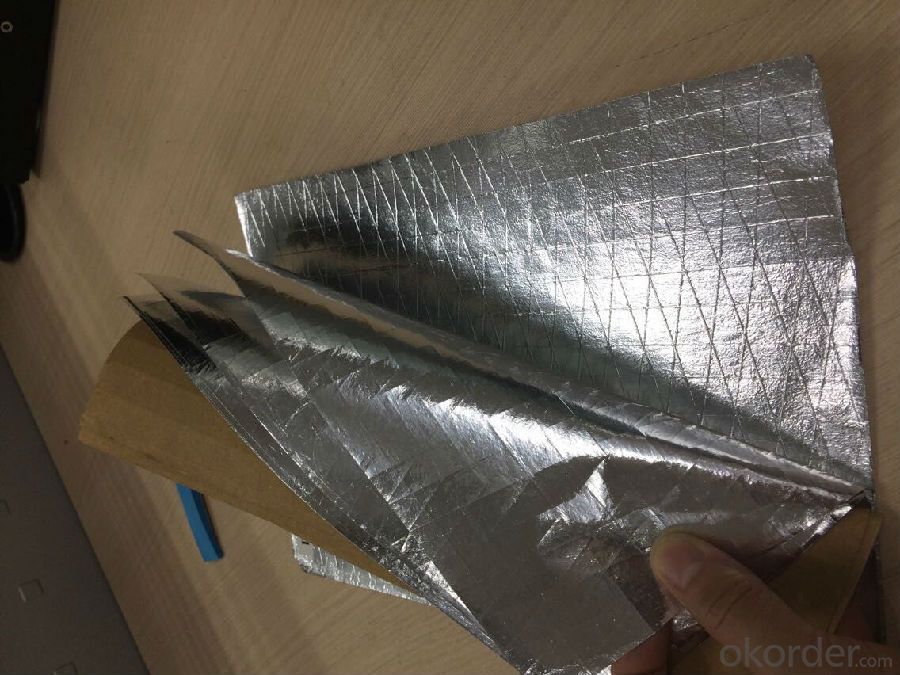
4. Aluminium Foil Facing Insulation Specification
a) Foil: 7μm
b) 2-way scrim: 12.5 x 12.5mm space
c) Polyethylene
d) Kraft: 50gsm, natural
2) FSK716B:
a) Foil: 7μm
b) 2-way scrim: 12.5 x 12.5mm space
c) Polyethylene
d) Kraft: 60gsm, natural
3) Roll width: 1.0, 1.2, 1.25, 1.30m
4) Roll length: 60, 120, 300, 500, 1600, 2750m
Physucal Properties | Test Method | Values (English) | Values(Metric) |
Basis Weight | Scale | 25.5lbs/1000 ft2 | 125g/m2 |
Tensile Strength | GB/T12914-1991 | 22.5lbs/inch(MD) | 3.79 kn/m(MD) |
13.9lbs/inch(XD) | 2.31 kn/m(XD) | ||
Bursting Strength | GB/T454-2002 | 36 lbs/psi | 248 kpa |
Water-resitant | 23 °C 24h | No phenomenon of layered | No phenomenon of layered |
Low-temperature resistant | -40 °C 1h | No phenomenon of layered | No phenomenon of layered |
High temperature resistant | 116 °C 4h | No leakage phenomenon | No leakage phenomenon |
Thickness | Micrometer | 0.0058 inch | 150 micron |
5.FAQ
We have organized several common questions for our clients,may help you sincerely:
①How about your company?
A world class manufacturer & supplier of castings forging in carbon steel and alloy steel,is one of the large-scale professional investment casting production bases in China,consisting of both casting foundry forging and machining factory. Annually more than 8000 tons Precision casting and forging parts are exported to markets in Europe
,America and Japan. OEM casting and forging service available according to customer’s requirements.
②How to guarantee the quality of the products?
We have established the international advanced quality management system,every link from raw material to final product we have strict quality test;We resolutely put an end to unqualified products flowing into the market. At the same time, we will provide necessary follow-up service assurance.
③How long can we receive the product after purchase?
The purchase of product within three working days, We will arrange the factory delivery as soon as possible. The pecific time of receiving is related to the state and position of customers.Commonly 7 to 10 working days can be served.
- Q: What are some frequent errors individuals commit when employing aluminum foil in culinary practices?
- <p>Common mistakes when using aluminum foil in cooking include: 1) Using foil that's too thin, leading to tearing during cooking. 2) Not allowing for proper air circulation, which can result in uneven cooking or steaming instead of roasting. 3) Wrapping foods too tightly, which can prevent even cooking and may cause the foil to stick to the food. 4) Using foil with non-stick coatings on the inside, which can flake off and contaminate the food. 5) Overlapping the foil edges, which can cause food to leak out. 6) Not using enough foil, which can lead to spills and messes in the oven. 7) Not preheating the oven before placing foil-wrapped foods inside, which can lead to uneven cooking. 8) Not greasing the foil before placing food on it, which can cause sticking. Proper use of aluminum foil can enhance cooking and prevent these issues.</p>
- Q: Is it possible to use aluminum foil as a surface for cooking pancakes?
- <p>While it's technically possible to cook a pancake on aluminum foil, it's not recommended. Aluminum foil is not designed for direct food contact at high temperatures, as it can potentially transfer aluminum to the food, which may be harmful. Additionally, the foil may not distribute heat evenly, leading to uneven cooking. Instead, use a non-stick pan or a griddle specifically designed for cooking pancakes to ensure even heat distribution and safe food preparation.</p>
- Q: How should aluminum foil be stored when not in use to maintain its facing orientation?
- <p>The best way to store aluminum foil is to keep it in its original box or a resealable container with the shiny side facing outward. This prevents the foil from sticking together and makes it easier to use. If the box is not available, you can also use a rubber band to wrap the foil around a cardboard tube, ensuring the shiny side is facing out, or place it in a container with a paper towel on the bottom to prevent sticking.</p>
- Q: What safety measures should be considered when using aluminum foil in a kitchen setting?
- <p>When using aluminum foil in the kitchen, it's important to handle it carefully to avoid cuts from sharp edges. Always use a cutting board when cutting foil to prevent damage to countertops. Avoid using aluminum foil with non-stick cookware, as it can scratch the surface. Do not use aluminum foil in broilers or ovens above 450掳F (232掳C), as it can melt and release toxic fumes. Never use aluminum foil to wrap foods that will be cooked in a microwave, as it can cause sparks and fires. Always ensure that foil is properly secured when used to cover food to prevent it from coming into contact with the heating elements of the oven.</p>
- Q: Can aluminum foil be shaped into a roasting rack?
- <p>Yes, you can create a makeshift roasting rack using aluminum foil. To do this, take two long sheets of aluminum foil and fold them back and forth to create a series of parallel ridges. These ridges will provide support for your roast while allowing air to circulate underneath. Place the folded foil on a baking sheet, spacing the ridges evenly apart to create a grid-like pattern. Your roast can then be placed on top of this foil 'rack' for cooking. This method is a simple and effective way to elevate your food for better heat distribution and crisping.</p>
- Q: Is it safe or advisable to use aluminum foil with a reflective side to wrap vegetables?
- <p>Yes, you can use aluminum foil facing to wrap vegetables. Aluminum foil is commonly used in cooking for wrapping, storing, and cooking food, including vegetables. The reflective side of the foil can actually help in heat distribution and may aid in cooking the vegetables more evenly. However, it's important to ensure that the foil does not come into direct contact with any part of the vegetable that could be damaged by heat, and to avoid using foil with non-stick coatings on it, as these can deteriorate at high temperatures. Always follow safety guidelines for using aluminum foil in cooking.</p>
- Q: Is it possible to enhance the flavor of food by using aluminum foil facing?
- <p>Yes, using aluminum foil facing can help make food more flavorful. It can seal in moisture and steam, which helps to keep the food juicy and tender. The foil also allows for even heat distribution, which can enhance the cooking process and the development of flavors. However, it's important to note that aluminum foil should not be used with acidic foods as it can react and potentially leach into the food. Additionally, for certain dishes, direct contact with the heat source can be necessary for achieving a desired texture or flavor, so the use of foil should be considered based on the specific recipe and cooking method.</p>
- Q: Is it safe and hygienic to repurpose a piece of aluminum foil that was previously used for wrapping food?
- <p>It is generally not recommended to reuse aluminum foil that has been in contact with food. Used foil can have residues of food, grease, and bacteria, which can contaminate new food items. Additionally, the foil can tear or become thin in areas, reducing its effectiveness and potentially allowing food to stick to previously used, contaminated areas. For椋熷搧瀹夊叏 and hygiene, it's best to use a fresh piece of aluminum foil each time.</p>
- Q: Is it safe or practical to use aluminum foil as a facing material for cooking purposes?
- <p>Yes, aluminum foil facing can be used for cooking, but with caution. It's often used to line baking sheets, cover dishes for steaming, or wrap foods for roasting. However, it's not recommended for direct contact with acidic or salty foods as it can react and leach aluminum into the food. Also, avoid using it at high temperatures as it can melt and release harmful fumes. Always follow the manufacturer's guidelines for safe use.</p>
- Q: This question asks for methods to prevent food from sticking to the aluminum foil surface during cooking.
- <p>To prevent food from sticking to the surface of aluminum foil when cooking, you can lightly coat the foil with a thin layer of cooking oil or non-stick spray before placing the food on it. This creates a barrier between the food and the foil. Additionally, ensure the foil is not torn or damaged, as this can cause food to stick. Using a heavier gauge foil can also help reduce sticking. Finally, avoid overcrowding the food on the foil, as this can cause it to stick due to uneven cooking and steam build-up.</p>
Send your message to us
CNBM Aluminum Foil Facing for Building Materials
- Loading Port:
- Shanghai
- Payment Terms:
- TT OR LC
- Min Order Qty:
- 200 m²
- Supply Capability:
- 1000000 m²/month
OKorder Service Pledge
OKorder Financial Service
Similar products
Hot products
Hot Searches
Related keywords
